Show Classes
There are literally thousands of different varieties of Koi, with new ones appearing every few years and older ones disappearing at an even greater rate. At Koi Shows the varieties are segregated into just 13 groups known as Show or Benching Classes. There are several different governing bodies in the world of Koi Shows, e.g. The BKKS, the AKCA (Associated Koi Clubs of America) and the ZNA - Zen Nippon Arinkai (All-Japan Association of Koi Hobbyists), all of which have slight variations in their Show Classes. The descriptions below are based entirely on those used during this show; those of the BKKS. The descriptions are intended to be an aid to beginners and we therefore keep to the basics and avoid all but the basic terminology. All of the fish shown as examples are fish that have been on display at a South East show with just one exception.
Kohaku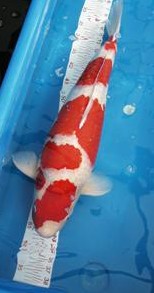
|
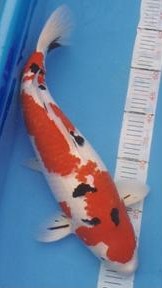
Sanke |
Showa
|
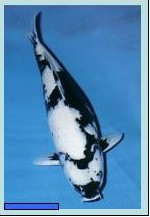
Utsurimono |
Bekko |
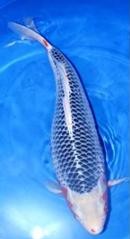 Asagi/Shusui |
Koromo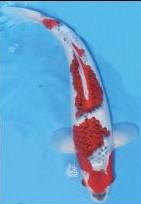 |
Kinginrin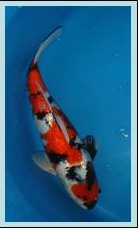 KinGinRin is an amalgamation of three Japanese words, Kin = Gold, Gin = Silver and Rin = Scales, which literally sums up this class - fish with gold & silver in their scales. Please note the emphasis on the 'in'. Fish given this name can be any variety at all with the addition of gold and/or silver flecks in their scales. The example shown (right) is a Gin Rin Showa. For show purposes only fish from the varieties Kohaku, Sanke, and Showa are benched in this class. All other varieties will be benched under their variety as though they had no kinginrin.The term Kinginrin is generally shortened to Ginrin in everyday use. KinGinRin is an amalgamation of three Japanese words, Kin = Gold, Gin = Silver and Rin = Scales, which literally sums up this class - fish with gold & silver in their scales. Please note the emphasis on the 'in'. Fish given this name can be any variety at all with the addition of gold and/or silver flecks in their scales. The example shown (right) is a Gin Rin Showa. For show purposes only fish from the varieties Kohaku, Sanke, and Showa are benched in this class. All other varieties will be benched under their variety as though they had no kinginrin.The term Kinginrin is generally shortened to Ginrin in everyday use. |
Tancho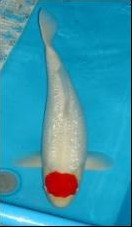 To be classed as a Tancho a koi needs to have a red pattern on its head and nowhere else. The pattern can be any shape but balanced and symmetrical shapes are preferred. Like the Ginrin this term can apply to any variety, but for Showing the class is restricted to just Tancho-Kohaku, Tancho-Sanke and Tancho-Showa. Should a Tancho have Ginrin as well, (see the example on left) it remains in the Tancho class for show purposes, purely based on the fact that the Tancho Class was invented long before that of the Kinginrin class. To be classed as a Tancho a koi needs to have a red pattern on its head and nowhere else. The pattern can be any shape but balanced and symmetrical shapes are preferred. Like the Ginrin this term can apply to any variety, but for Showing the class is restricted to just Tancho-Kohaku, Tancho-Sanke and Tancho-Showa. Should a Tancho have Ginrin as well, (see the example on left) it remains in the Tancho class for show purposes, purely based on the fact that the Tancho Class was invented long before that of the Kinginrin class. |
Kawarimono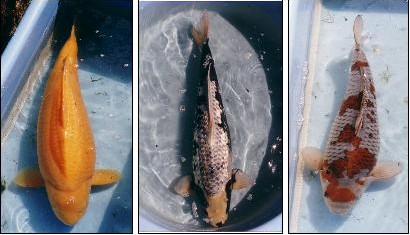 |
Hikarimuji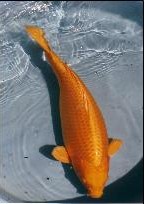 This and the next two Show classes are for all the metallic skinned varieties, favoured by many a hobbyist. The Hikari-muji class is reserved for the single coloured varieties, such as Purachina, Yamabuki and Ogon. Metallic Matsubas are also found in this class as the matsuba feature is considered a scale characteristic and not a colour. Matsuba fish have a brown smudge at the root of each scale given the fish the pattern of a pinecone, which is what the literal translation of Matsuba means. |
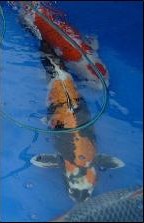
HikariutsuriThis class is for metallic versions of Showa and Utsuri. The most common variety found here is the Kin-Ki-Utsuri - a metallic version of the Ki-Utsuri a very popular fish. The example shown (right) is of the less common Kin Showa. |
Hikarimoyo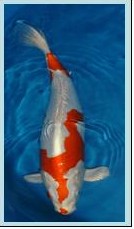 This final class is for any metallic skinned fish not covered by the two classes above. Therefore, as you would imagine this class has many varieties. The example shown (left) is a Kikusui. Other varieties include - Ginsui, Hariwake, Tora-ogon, Shochikubai, Yamatonishiki, Ki-kikuryu, and Kujaku.
|